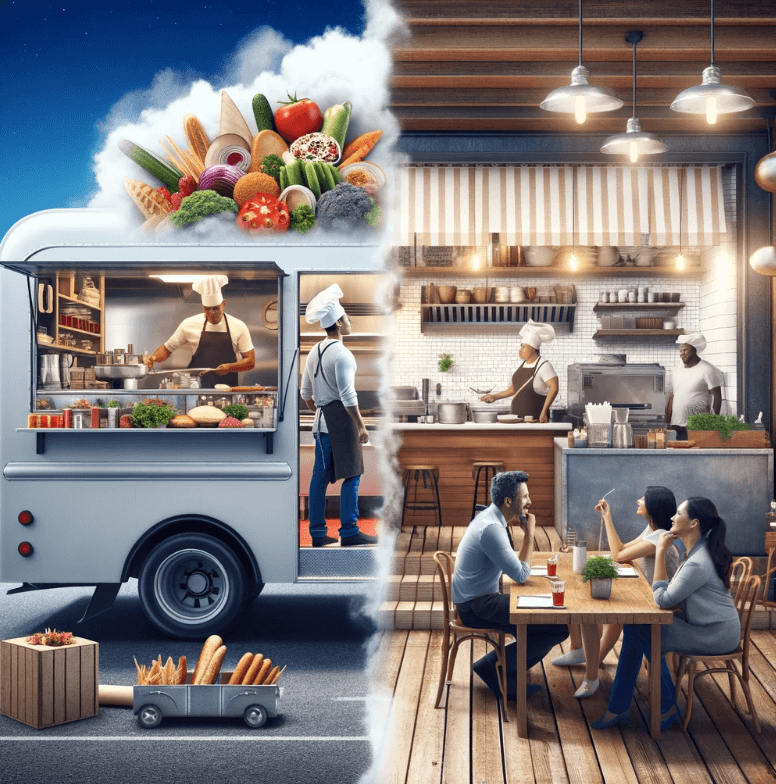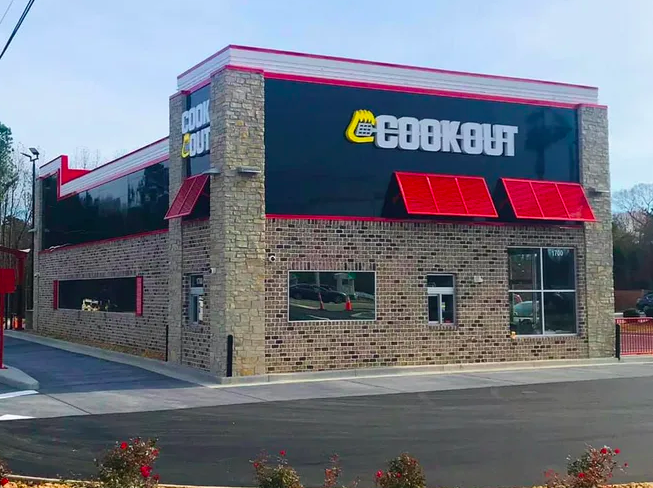If you have been paying attention to the mobile food industry you may have noticed that more and more food truck owners have made the leap into brick and mortar restaurant locations. Most of these transitions have been years in the making. Here’s what to consider before expanding a little food truck into a the big time of restaurant ownership.
Page Contents
The Transition from Food Truck to Restaurant
Here’s are six things to consider before making the shift to sign a longterm restaurant lease.
Know what your restaurant wants to be.
We highly recommend that you spend the time and resources to develop of your restaurants brand strategy. This must happen long before to opening your doors. Will your restaurant expand on your food truck’s menu? Will it take over for the truck, or will it become your truck’s commissary?
What’s in a name?
While selecting a name for a restaurant can be difficult for beginners, food truck vendors already have a name to use. The key question is how to use your truck’s name to brand your restaurant. We recommend that you try to look at the name through your target consumer’s eyes. What would push them to choose your restaurant over your food truck or a competitor’s?
Invest in a well-designed sign
As you know, consumers will always judge you on their first impression — which is usually your logo and sign. Your food truck used a wrap, but this won’t work for your storefront. If your restaurant has synergy with your food truck, keep what you have just convert it into proper signage. If you are planning to have your restaurant’s menu differ from your truck’s let people know through your signage.

There’s a transition going from food truck to restaurant.
Make the menu manageable.
The easiest way to build your first restaurant menu is to use your knowledge of the success you’ve had on your truck. While most food trucks limit their menu’s to 5 or 6 entrees, your restaurant can use these items as well as others that have been successful in the past. Understand what your restaurant team can manage, and deliver on it consistently when you first open your doors. It is much easier to grow your menu than to shrink it. People prefer surprises, like new additions to the menu, as opposed to discovering the thing that they liked is no longer available.
Understand what your customers want.
The atmosphere that restaurants and food trucks provide will always differ. Speak with your food truck customers to find out what they would expect from your restaurant. Do they want a romantic environment with mood lighting and comfy chairs, or a more upbeat atmosphere with jazzy music and interesting art on the walls? Understanding what your consumer wants and or needs from you and meets with their expectations will keep them coming back time and time again for a consistent experience.
Stay true to your concept.
Ask yourself if each and every component of the restaurant measures up the concept that you built with your food truck. Insure that all pieces complement one another. Make sure this move fits in with your food truck’s business plan.
Finding Restaurant Locations
Want to move forward? Here’s how find your first restaurant location.
Conduct Market Research
Just like you did when you started up your food truck, you had to do your homework. What locations will be best to open a new restaurant? Understanding where your existing customers are will give you a great head start. Find a restaurant location where where your truck has seen enthusiastic support. You need to know if the prospective restaurant location has enough people, with enough expendable income, to spend money at your new food truck restaurant. Ultimately, if the answer is no, then find another location.
Check The History Of Landlord/Location
Once you’ve found a location for your restaurant, find out as much as you can about your potential new landlord. If there are other businesses in the same location, ask other business owners if the landlord is easy to work with and how they handle building issues. Also, check the history of the location. Have multiple restaurants opened and rapidly closed in in this location? You may have a great concept, but if you find a location that has parking or visibility issues, you need to find this out before signing a lease.
Know Your Budget
You may find the perfect place to open your food truck restaurant, but if the rent is too high, don’t get too attached. Just like you never entered a food truck event you couldn’t afford, the same is true of renting a restaurant space. Just like your food truck, the early years of a new restaurant are pretty tight financially.
Read Your Lease/Rental Agreement
Is heat, water, electricity included in rent or lease payment? What about trash removal, building repairs and general maintenance. Your food truck restaurant lease must detail exactly what expenses your landlord will cover. The lease will define who is responsible for required renovations, and what expenses you will pay for.
Have an Exit Plan
Although many landlords will offer lower lease payments for longer termed leases, don’t get too far ahead of yourself. A lease for two years is great. Five years, is starting to get carried away. But if a landlord approaches you with a ten year lease, RUN! No one likes to think about their food truck restaurant closing, especially before opening, but the reality is, a majority of new restaurants close within the first couple of years. If after the first term of the lease expires and everything looks good financially, sign a longer lease.
What are the Risks?

Growing a business always comes with risk.
Transitioning from a food truck to starting a restaurant concept involves several risks, primarily due to the significant differences in operational and financial models between the two. Here are some of the risks involved:
- Higher Costs: Opening a restaurant requires a substantial initial investment. Unlike a food truck, where costs are relatively lower and include the vehicle, initial inventory, and permits, a restaurant demands more. You’ll need to consider the cost of leasing or purchasing property, renovations to fit the restaurant’s theme, kitchen equipment, furniture, and more. These upfront expenses are much higher compared to the average cost of starting a food truck. You could easily invest $750,000 – $1 million to open a restaurant in a desirable location.
- Lease Commitment: Launching a restaurant typically involves signing a lease for the property, binding you to a fixed location for a predetermined period. This long-term financial commitment adds a layer of risk, especially if the chosen location does not attract enough customers or if the business faces unexpected challenges.
- Operational Costs: Running a restaurant incurs ongoing operational costs, including utilities, staff salaries, maintenance, and insurance, which are generally higher. These costs accumulate regardless of the business’s performance, posing a financial risk if the restaurant does not generate expected revenues.
- Fixed Schedule: Unlike food trucks, which offer the flexibility to operate only during peak times or seasons and move to different locations based on demand, a restaurant must maintain a consistent schedule year-round. This requires a steady flow of customers daily to cover expenses, making it challenging during slow periods.
- Food Truck Flexibility: Food truck vendors enjoy more operational flexibility. They can adjust their working hours, menu, and location based on customer preferences, weather conditions, and participation in events or festivals. Transitioning to a fixed restaurant setting eliminates this flexibility, potentially impacting the business’s ability to adapt quickly to market changes.
Considering these risks, it’s crucial for food truck owners to conduct thorough market research, financial planning, and strategic analysis before transitioning to a restaurant concept. There’s no right or wrong answer. Only what’s right for you and your situation!
Can You Make the Leap?
I’m happy to report there are many food truck owners that have transitioned into restaurant owners over the years. The story of The Peached Tortilla, a renowned Asian fusion restaurant in Austin is one example.
The brand began modestly more than 15 years ago when Eric Silverstein decided to rent a food truck. Silverstein had a vision to merge Asian and Southern cuisines, introduced Austin to a menu that was both unique and flavorful. The food truck quickly found its audience, attracting those eager to try Silverstein’s innovative dishes.
Reflecting on the early days, Silverstein shared, “Starting with just a rented food truck, I knew we had something special, but the journey ahead was a blend of excitement and challenges. Every day was a learning experience, and seeing customers enjoy our food was incredibly rewarding.”
The initial success of the food truck created a foundation for expansion. With a growing base of loyal customers, Silverstein saw an opportunity to move from a mobile operation to a more permanent setting. This transition marked the beginning of a new chapter for The Peached Tortilla.
Over the years, The Peached Tortilla has expanded beyond a single food truck to include multiple restaurants and bars in Austin. Each location echoes the brand’s commitment to quality and innovation while offering a space that reflects the local vibe. The expansion allowed The Peached Tortilla to not only diversify its menu but also to offer catering services and host events, further cementing its role in Austin’s culinary and social scene.
The Peached Tortilla stands as a testament to what passion and perseverance can achieve. From a single food truck to a celebrated multi-location brand, The Peached Tortilla’s journey is an inspiring example of growth and innovation in the food industry. If you have a concept that works well on wheels, I don’t see any reason why you couldn’t make the transition to restaurant ownership.




